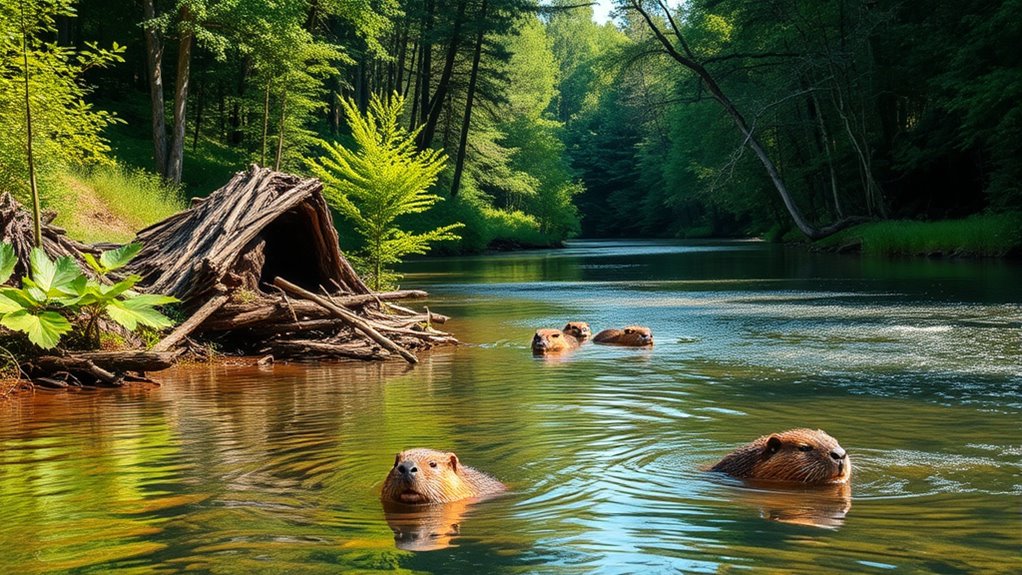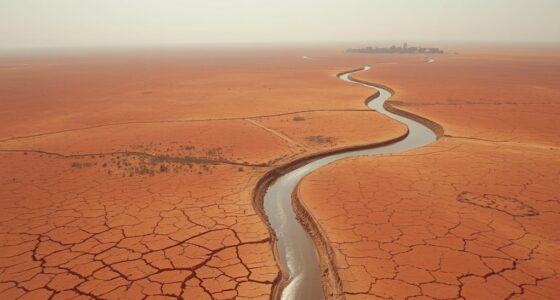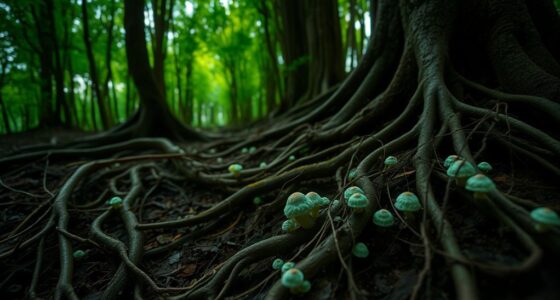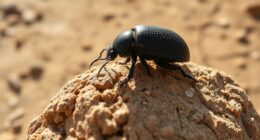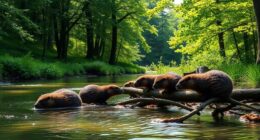The return of beavers marks one of Europe’s most successful rewilding stories, transforming landscapes and restoring ecosystems through their natural engineering. They create ponds and wetlands that improve water quality, reduce floods, and support diverse wildlife. Their activity helps stabilize banks, filter pollutants, and promote healthier habitats. By reintroducing beavers, you see how they revitalize entire environments, showcasing nature’s incredible ability to heal itself. If you continue exploring, you’ll discover how this remarkable success unfolds across Europe.
Key Takeaways
- Beavers are vital ecosystem engineers that restore wetlands, improve water quality, and increase biodiversity across Europe.
- Reintroduction efforts have successfully revived beaver populations, transforming landscapes into thriving, natural habitats.
- Beaver activity buffers ecosystems against climate change impacts like droughts and floods through wetland creation.
- Their presence enhances landscape resilience, supports wildlife, and benefits agricultural and human water needs.
- The return of beavers exemplifies a successful rewilding initiative that promotes ecological stability and environmental health.
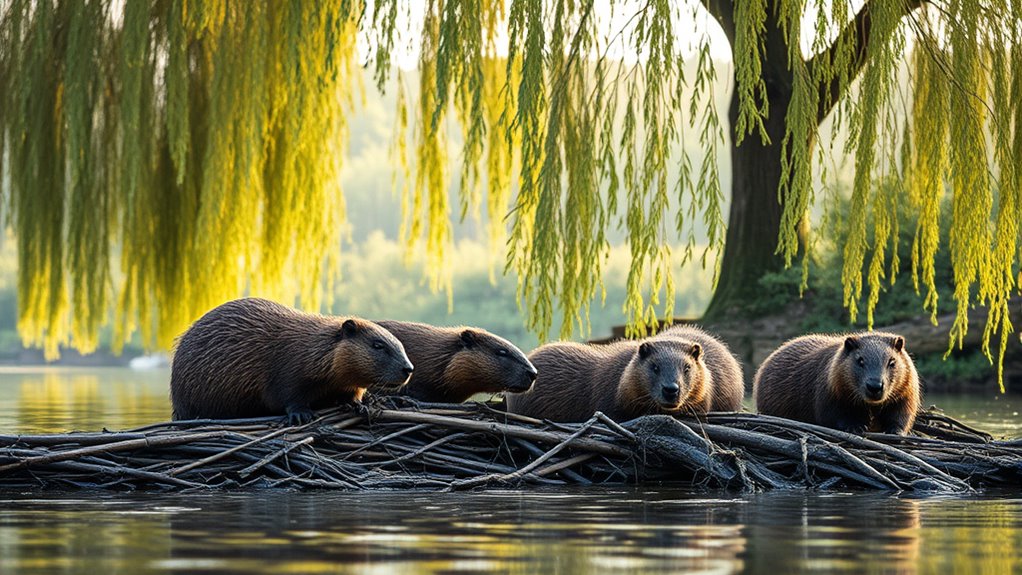
Rewilding efforts across Europe have demonstrated that beavers are key agents in restoring natural ecosystems. As you observe their return, you begin to understand how essential they are to the health of local environments. Beavers thrive in diverse beaver habitats, which include streams, ponds, and wetlands. These habitats aren’t just cozy homes; they’re fundamental for supporting a wide array of plant and animal species. When beavers build their dams, they create ponds that slow water flow, helping to prevent erosion and improve water quality. This process boosts ecosystem benefits, such as increased biodiversity, better groundwater recharge, and more resilient landscapes.
Beavers create vital habitats that support biodiversity, prevent erosion, and enhance water quality across European ecosystems.
You’ll notice how beaver activity transforms the landscape. Their dams flood certain areas, forming wetlands that serve as habitats for amphibians, insects, and waterfowl. These wetlands also act as natural water filters, trapping sediment and pollutants. As a result, downstream water bodies experience better clarity and quality. The presence of beavers encourages the growth of native plants, which stabilize banks and provide food and shelter for countless creatures. Their engineering works effectively turn small streams into thriving ecosystems, demonstrating how beavers are nature’s engineers. Ecosystem restoration plays a crucial role in supporting these environmental benefits.
By restoring beaver populations, you directly contribute to a cascade of ecological benefits. The creation of ponds and wetlands promotes a more diverse and resilient environment. These areas serve as breeding grounds and refuges during droughts or floods, helping maintain ecological stability. Additionally, beaver activity can reduce the severity of floods by storing excess water during heavy rains. The increased water retention in wetlands also supports agricultural lands and human settlements by maintaining steady water supplies.
Seeing beavers in action, you realize their role extends beyond habitat creation. Their dams and lodges influence nutrient cycles, promoting nutrient retention and cycling within ecosystems. This enhances plant growth and supports various wildlife species. Furthermore, by maintaining a network of wetlands, beavers help mitigate climate change impacts, such as droughts and extreme weather. Their natural engineering fosters healthier, more sustainable landscapes that benefit both nature and local communities.
In essence, rewilding with beavers isn’t just about bringing back a species; it’s about reviving entire ecosystems. Their ability to modify landscapes through their natural behaviors demonstrates how indispensable they are for ecological restoration. You see firsthand how their presence delivers a suite of ecosystem benefits that help heal and sustain Europe’s natural environments. Reintroducing beavers proves that nature’s engineers are irreplaceable allies in the ongoing effort to restore and preserve our planet’s ecological balance.
Frequently Asked Questions
How Do Beavers Affect Local Fish Populations?
You might wonder how beavers influence fish populations. By creating ponds and dams, beavers improve fish habitats and support diverse aquatic ecosystems. Their dams slow water flow, helping fish avoid strong currents and increasing spawning areas. Additionally, the ponds they build provide shelter and food sources. Overall, beavers positively impact local fish populations by enhancing habitat complexity and promoting healthy, thriving aquatic ecosystems.
Are Beaver Reintroductions Economically Beneficial?
You’ll find that beaver reintroductions offer significant economic impact and ecological benefits. As beavers restore wetlands, they improve water quality, boost biodiversity, and attract eco-tourism, generating income for local communities. These ecological benefits help reduce flood risks and enhance fisheries. Overall, reintroducing beavers can lead to sustainable economic growth by supporting natural ecosystems, making them a valuable investment for long-term environmental and economic health.
What Challenges Do Beavers Face in Urban Areas?
You’ll find that beavers face many urban obstacles, like limited natural habitat and pollution, making it hard for them to thrive. Human-beaver conflicts often arise when they dam waterways or flood areas, causing property damage. Managing these issues requires balancing conservation efforts with human needs, which can be challenging. Urban environments demand careful planning to reduce conflicts, protect beavers, and promote coexistence.
How Do Beaver Dams Influence Water Quality?
Beaver dams positively influence water quality by improving beaver habitats and reducing water pollution. As you observe, dams slow down water flow, allowing sediments and pollutants to settle, which cleans the water. They also promote biodiversity by creating diverse habitats for aquatic life. By maintaining healthy beaver populations, you help enhance water quality and support ecosystems, making areas more resilient and better suited for wildlife and human needs alike.
Can Beavers Survive in Extreme Weather Conditions?
Imagine beavers as resilient sailors steering a stormy sea. In extreme weather, they adapt by finding shelter and building better habitat structures, showcasing their climate resilience. You’ll find beavers in diverse beaver habitats, including cold, harsh winters or hot, dry summers. Their ability to survive these conditions highlights their essential role in ecosystem health, helping to stabilize water systems and support biodiversity even when weather turns fierce.
Conclusion
As you watch beavers return, it’s like witnessing nature’s gentle rebirth, carving new rivers and shaping landscapes with a craftsman’s touch. Their busy dams become woven tapestries of life, inviting countless creatures to thrive. You’re part of a story where resilience and patience release miracles, turning once-empty waters into vibrant symphonies of rewilding. So, embrace this watery renaissance—beavers are rewriting Europe’s wild story, one ripple at a time.
